
Modern Organocopper Chemistry
.pdf
228 7 Copper-catalyzed Enantioselective Conjugate Addition Reactions of Organozinc Reagents
atom and an elongated zinc–carbon bond is created, resulting in enhanced reactivity of the dialkylzinc reagent (Scheme 7.6(a)) [29].
Scheme 7.6. Activation of organozinc reagents.
Organozinc reagents can be converted into more reactive organometallic reagents RMLn [28], as has been demonstrated for Ni, Cu, Pd, and Ti [5, 31]. Transmetalation is therefore most probably the key step in copper-catalyzed 1,4-additions of R2Zn reagents, with alkyl transfer from Zn to Cu generating organocopper reagents in situ (Scheme 7.6(b)) [28]. In view of the complex nature of many organocopper reagents [32, 41], it needs to be emphasized that other formulations, such as bimetallic Zn/Cu reagents, are perhaps more realistic.
Another important feature is the reduced basicity of R2Zn reagents [27, 29]. The tolerance of organozinc reagents for functional groups (esters, nitriles) set them apart from many other organometallic systems, such as organolithium and Grignard reagents [28]. A number of R2Zn reagents are commercially available, but an important practical consideration in the use of organozinc reagents in 1,4- addition is the option of starting with an enone and an alkene (Scheme 7.7).
Scheme 7.7. Alkenes as starting materials in 1,4-additions involving (functionalized) organozinc reagents.
The R2Zn reagents are readily prepared from the corresponding (functionalized) alkene by hydroboration and subsequent boron-zinc exchange, according to the

7.3 Copper-catalyzed 1,4-Addition 229
procedure of Knochel et al. (Scheme 7.8) [8, 28, 33]. Alternatively, they are accessible from the Grignard reagents by transmetalation, following the method introduced by Seebach et al. [5c, 34], but removal of halide is required since the presence of salts is usually detrimental in the subsequent catalytic asymmetric CaC bond-formation.
Scheme 7.8. Nickel-catalyzed 1,4-addition, using alkene hydroboration and boron-zinc exchange.
7.3
Copper-catalyzed 1,4-Addition
7.3.1
Phosphoramidite-based Catalysts
The numerous studies prior to 1996 on Cu-catalyzed additions of Grignard reagents to cyclohexenone as a model substrate revealed that, with a few exceptions, enantioselectivity was exclusively found with either cyclic substrates (Grignard reagents) or acyclic substrates (dialkylzinc reagents) (Scheme 7.2).
The first application of a copper-catalyzed conjugate addition of diethylzinc to 2-cyclohexenone, using chiral phosphorous ligand 12, was reported by Alexakis (Fig. 7.1) [35]. An ee of 32% was obtained.
It appears from these early studies that modest to rather high yields and enantioselectivities can be achieved with structurally very diverse chiral ligands. Furthermore, both relatively hard (amino alcohols) and soft (thiols, phosphines) ligands
Fig. 7.1. Structures of phosphorus ligands 12 and 13.
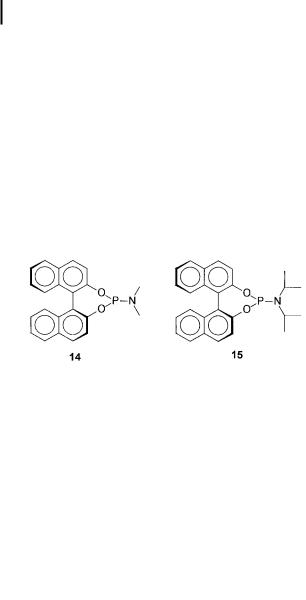
230 7 Copper-catalyzed Enantioselective Conjugate Addition Reactions of Organozinc Reagents
produce active catalysts for 1,4-additions of Grignard and R2Zn reagents. A critical analysis of copper-catalyzed 1,4-additions revealed that several competing catalytically active complexes, including achiral ones, might be present. A question that therefore played a decisive role in our discovery of the first catalytic, enantioselective 1,4-addition of an organometallic reagent with ees exceeding 98% was that of how e cient ligand-accelerated catalysis might be achieved [30]. In anticipation that the catalytic activity might be enhanced by fine-tuning of the steric and electronic properties of the ligands, phosphoramidites were introduced as a novel class of chiral ligands for copper [36].
Phosphoramidites 13, derived from 2,20-binaphthol, proved to be versatile ligands for copper-catalyzed 1,4-additions of Et2Zn to chalcone and 2-cyclohexenone (Scheme 7.9) [37].
Scheme 7.9. Copper-catalyzed 1,4-addition to cyclohexenone and chalcone, with phosphoramidites as chiral ligands.
With these catalysts (3 mol%), prepared in situ from CuI or CuOTf and ligand 14, the following observations were made:
(1)high activity; complete conversions were reached in less than 3 h at 35 C (isolated yields 75–88%),
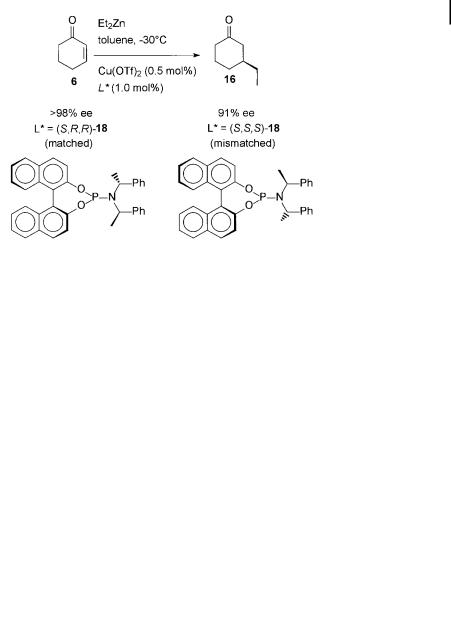
7.3 Copper-catalyzed 1,4-Addition 231
(2)excellent chemoselectivities and regioselectivities (> 95%) for 1,4-addition,
(3)significant ees both with cyclic and with acyclic enones; a feature notably absent with previous catalysts.
Use of ligand 15, with a sterically more demanding diisopropylamine moiety, further increased the enantioselectivity.
Another significant improvement, resulting in better catalyst solubility and slightly enhanced ee values, was found when Cu(OTf )2 was used. The ease of handling of Cu(OTf )2, compared to that of CuOTf, is a major advantage for applications of this catalytic system in synthesis. The copper(II) complex is most probably reduced in situ to a copper(I) complex, which functions as the actual catalyst.
The most important findings using the catalytic system based on Cu-ligand 15 are:
(1)strongly ligand-accelerated catalysis, and
(2)Et2Zn addition to 4,4-dimethyl-2-cyclohexenone and chalcone with 81% ee and 90% ee, respectively.
A breakthrough was achieved with chiral phosphoramidite ðS; R; RÞ-18, in which a C2-symmetric (S)-binaphthyl unit and a C2-symmetric ðR; RÞ-bis-(1-phenylethyl)- amine unit are present (Scheme 7.10), resulting in the enantioselective catalytic 1,4-addition of Et2Zn to 2-cyclohexenone (6) with >98% ee [38].
Scheme 7.10. Enantioselective 1,4-addition of Et2Zn to cyclohexenone with Cu(OTf )2-matched ðS; R; RÞ-18 and Cu(OTf )2-mismatched ðS; S; SÞ-18 phosphoramidites.
The presence of two chiral units in ligand 18 results in a matched ðS; R; RÞ and a mismatched ðS; S; SÞ combination. The absolute stereochemistry of the product is controlled by the BINOL moiety and the amine component has a distinct e ect in
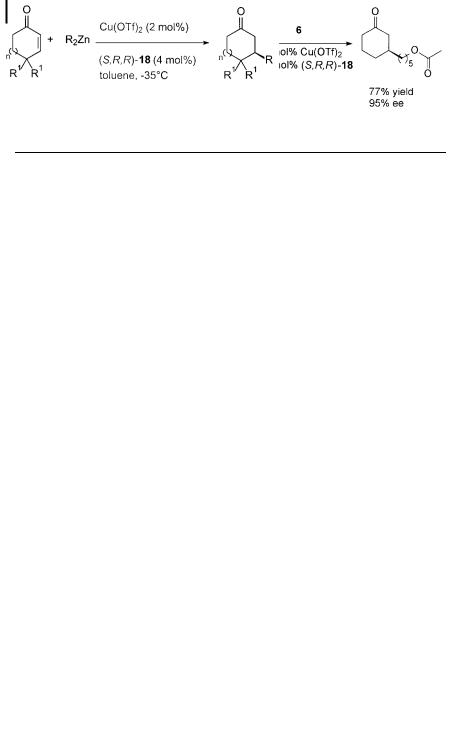
2327 Copper-catalyzed Enantioselective Conjugate Addition Reactions of Organozinc Reagents
Tab. 7.1. Enantioselective 1,4-addition of R2Zn reagents to cyclic enones, catalyzed by Cu(OTf )2/(S; R; R)-18.
R |
R1 |
n |
Yield (%) |
ee (%) |
C2H5 |
H |
1 |
94 |
>98 |
C2H5 |
H |
0 |
75 |
10 |
C2H5 |
H |
2 |
95 |
>98 |
C2H5 |
H |
3 |
95 |
97 |
C2H5 |
CH3 |
1 |
74 |
>98 |
C2H5 |
C6H5 |
1 |
93 |
>98 |
CH3 |
H |
1 |
72 |
>98 |
CH3 |
CH3 |
1 |
68 |
>98 |
C7H15 |
H |
1 |
95 |
95 |
i-C3H7 |
H |
1 |
95 |
94 |
(CH2)3C6H5 |
H |
1 |
53 |
95 |
(CH2)3CH(OC2H5)2 |
H |
1 |
91 |
97 |
fine-tuning the enantioselectivity. However, even the diastereomeric Cu catalyst derived from ðS; S; SÞ-18 still gave an ee of 91% [39]. The high selectivity and reactivity in this ligand-accelerated catalytic 1,4-addition was retained when the amount of catalyst used was reduced. When 6 was used as a substrate, turnover numbers larger than 3000 (95% ee) were found.
The examples given in Tab. 7.1 illustrate the scope of the Cu(OTf )2/ðS; R; RÞ-18- catalyzed 1,4-addition. With various R2Zn reagents, excellent yields and enantioselectivities are obtained for cyclic enones (except for cyclopentenone, vide infra) [6, 38, 80].
Functionalized alkyl groups are readily introduced through this catalytic procedure, while the level of stereoselectivity is not a ected by, for instance, the presence of an ester functionality in the R2Zn reagent (Scheme 7.11).
Scheme 7.11. Copper-catalyzed enantioselective 1,4-addition of a functionalized zinc reagent.

7.3 Copper-catalyzed 1,4-Addition 233
7.3.2
Catalytic Cycle
We have proposed a pathway, based on mechanistic studies in organocuprate and zincate chemistry [40–42] and the results of several catalytic experiments [37, 38], for the catalytic 1,4-addition (Scheme 7.12). Most probably, in situ reduction of Cu(OTf )2 takes place prior to the formation of the Cu(I)-phosphoramidite complex L2CuX. Subsequent alkyl transfer from zinc to copper gives L2CuR and RZnX. Complexation of the RZnX to the carbonyl group and formation of the p-complex between L2CuR and the enone results in complex 19. This step is followed by alkyl transfer, and the resulting zinc enolate 20, upon protonation, a ords b-substituted cycloalkanone 16. Alternatively, the enolate can be trapped with other electrophiles in tandem procedures (vide infra). The proposed mechanism is in accordance with the significant increases in reaction rates of 1,4-additions of cuprates produced by enone activation using Lewis acids [40–43] and with the well known p-complexation ability of organocopper species [20, 44]. In view of the high selectivities observed and taking into account that dinuclear species are involved in catalytic 1,2-additions of R2Zn reagents [26], 19 might well be formulated as a bimetallic complex in which the enone is bound in a fixed conformation that a ords highly p-face-selective addition.
Scheme 7.12. Catalytic cycle for 1,4-additions of R2Zn reagents.
The presence of two ligands in the active catalyst is proposed on the basis of the optimum ligand-to-copper ratio of 2 and the nearly identical selectivities of monodentate and bidentate phosphoramidites in the 1,4-addition of Et2Zn to 2- cyclohexenone [45].

234 7 Copper-catalyzed Enantioselective Conjugate Addition Reactions of Organozinc Reagents
The observation of nonlinear e ects, both with chalcone and with cyclohexenone, further supports this catalyst stoichiometry. The nonlinear e ects can be explained by the involvement of diastereomeric complexes L2CuR, with two chiral ligands bound to copper (Fig. 7.2) [45].
The X-ray structure of the CuI complex 21 of phosphoramidite 14 provides additional insight into a possible mechanism for stereocontrol (Fig. 7.3). The formation of the L2CuEt-enone complex involves substitution of the iodide in 21 for the alkyl moiety and of one of the ligands for the p-coordinated enone. Coordination of RZnX results in the bimetallic intermediate 19 (Fig. 7.3). The absolute configuration of the two phosphoramidite ligands and the pseudo-C2-symmetric arrangement dictate the formation of (S)-3-ethyl-cyclohexanone.
7.3.3
Variation of Ligands
A remarkable number of new BINOLand TADDOL-based chiral ligands for the copper-catalyzed conjugate addition of R2Zn reagents have recently been introduced, with both monodentate and bidentate ligands having proven capable of inducing high enantioselectivities [6, 11, 12, 46].
Yields and selectivities of BINOL-derived ligands in additions of Et2Zn and Me2Zn to 2-cyclohexenone are compiled in Tab. 7.2.
Pfaltz introduced phosphite ligands 22, with BINOL and chiral oxazoline units, which gives excellent enantioselectivities [47]. In phosphoramidites 14 and 15 (Scheme 7.9) the structure of the amine moiety is crucial, but substituents at the 3,30-positions of the BINOL unit had only minor influences on the enantioselectivity of the 1,4-addition to cyclohexenone. In contrast, the introduction of the two 3,30-methyl substituents in ligand 22 increased the ee drastically: from 54% to 90%.
Bidentate phosphorus ligands based on BINOL, such as phosphonite 23, phosphites 24 and 25, and phosphoramidite 26 (Tab. 7.2), with various bridging units were introduced by the groups of Reetz, Chan, and Waldmann [48–50]. Excellent enantioselectivities – up to 96% for ligand 23, for instance – were found.
Although the presence of BINOL in the ligands so far discussed has shown itself to be particular e ective, modification of the diol moiety provides new classes of ligands for this addition reaction. Alexakis, screening a number of chiral phosphites in the Cu(OTf )2-catalyzed 1,4-addition, showed that an ee of 40% could be obtained for the addition of Et2Zn to 2-cyclohexenone and of 65% for addition to chalcone, by using cyclic phosphites derived from diethyl tartrate [51].
The use of TADDOL-based ligands o ers an important alternative for coppercatalyzed asymmetric 1,4-additions. TADDOLs (a; a; a0; a0-tetraaryl-1,3-dioxolane- 4,5-dimethanol compounds), introduced by Seebach, are among the most successful currently known ligands in asymmetric catalysis. Seebach also developed the first copper-catalyzed 1,4-addition of a Grignard reagent using a TADDOL derivative as a chiral ligand (see Scheme 7.2) [17]. We have reported TADDOL-based
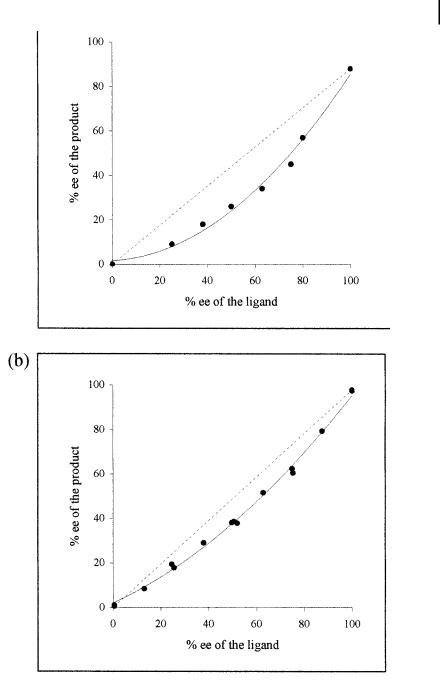
7.3 Copper-catalyzed 1,4-Addition 235
Fig. 7.2. Correlation between the ee of the ligand and that of the 1,4-addition product: a) chalcone (ligand 15) and b) 2- cyclohexenone (ligand 18).
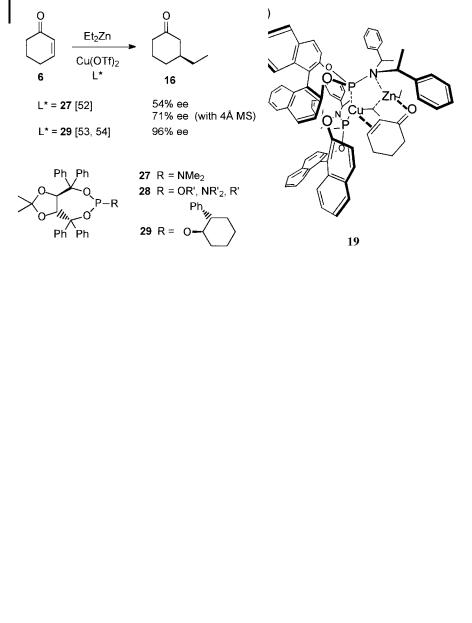
236 7 Copper-catalyzed Enantioselective Conjugate Addition Reactions of Organozinc Reagents
Fig. 7.3. a) X-ray structure of the CuI complex 21 of ligand 14; b) Possible bimetallic intermediate involved 19 in si-face- selective ethyl transfer to 2-cyclohexenone.
phosphoramidite 27 as a chiral ligand for Cu(OTf )2-catalyzed 1,4-addition of diethylzinc to 2-cyclohexenone, a ording an ee of 54% (Scheme 7.13) [52].
Scheme 7.13. TADDOL-based phosphoramidite ligands in the catalytic 1,4-addition.
Surprisingly, the enantioselectivity could be increased to 71% when powdered molecular sieves (4 A˚ ) were present during the reaction. This e ect might be due to traces of water, resulting in the formation of mixed zinc hydroxides and a ecting the stereoselectivity, or might be attributable to a catalytic reaction at the surface of the molecular sieves. A remarkable di erence between ligand 27 and BINOL phosphoramidite 18 is that with 27 the highest enantioselectivity is found with the
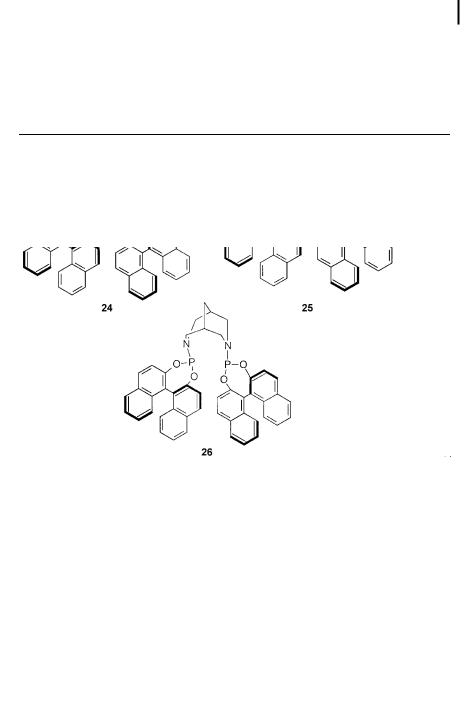
7.3 Copper-catalyzed 1,4-Addition 237
Tab. 7.2. Copper-catalyzed enantioselective 1,4-addition of R2Zn to 2-cyclohexenone using BINOL-type ligands.
Ligand |
Catalyst (mol%) |
R |
ee (%) |
Ref. |
|
|
|
|
|
22 |
3 |
Et |
90 |
47 |
|
|
Me |
96 |
47 |
23 |
1 |
Et |
96 |
48 |
24 |
1 |
Et |
90 |
49 |
25 |
1 |
Et |
90 |
49 |
26 |
1 |
Me |
82 |
50 |
|
|
|
|
|
